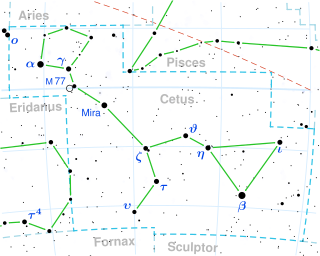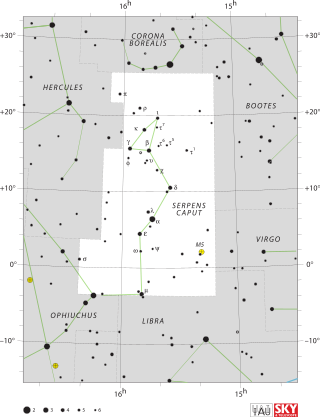
Nu Aurigae, Latinised from ν Aurigae, is the Bayer designation for a star in the northern constellation of Auriga. It is visible to the naked eye with an apparent visual magnitude of 3.96 and is approximately 200 light-years distant from the Earth. This is an evolved giant star with a stellar classification of G9.5 III. It is a red clump star, which indicates that it is generating energy through the fusion of helium at its core. The outer envelope has expanded to 18 times the radius of the Sun and cooled to 4,576 K, giving it the characteristic yellow-hued glow of a G-type star. It shines with 126 times the luminosity of the Sun.

Eta Ceti is a star in the equatorial constellation of Cetus. It has the traditional name Deneb Algenubi or Algenudi. The apparent visual magnitude of this star is +3.4, making it the fourth-brightest star in this otherwise relatively faint constellation. The distance to this star can be measured directly using the parallax technique, yielding a value of 120.5 light-years.

Tau Cassiopeiae is a solitary, orange hued star in the northern constellation of Cassiopeia. It is bright enough to be seen with the naked eye, having an apparent visual magnitude of +4.86. Based upon an annual parallax shift of 18.75 mas as seen from Earth, this system is located about 174 light years from the Sun.

Delta Crateris is a solitary star in the southern constellation of Crater. With an apparent visual magnitude of 3.56, it is the brightest star in this rather dim constellation. It has an annual parallax shift of 17.017 mas as measured from Earth, indicating Delta Crateris lies at a distance of 192 ly from the Sun.
HD 173780 is a single star in the northern constellation Lyra, near the southern constellation border with Hercules. It is an orange-hued star that is faintly visible to the naked eye with an apparent visual magnitude of +4.84. This object is located at a distance of approximately 237 light years from the Sun based on parallax, but is drifting closer with a radial velocity of −17 km/s.

Zeta Cygni is a binary star system in the northern constellation of Cygnus, the swan. It has an apparent visual magnitude of 3.26 and, based upon parallax measurements, is about 143 light-years away.
39 Cygni is a binary star system near the southern border of the northern constellation of Cygnus, approximately 270 light years away from Earth. It is visible to the naked eye as an orange-hued star with an apparent visual magnitude of 4.43. The system is moving closer to the Sun with a heliocentric radial velocity of −15 km/s.

52 Cygni is a giant star in the northern constellation of Cygnus with an apparent magnitude of 4.22. Based on its Hipparcos parallax, it is about 291 light-years (89 pc) away.
4 Vulpeculae is a single, orange-hued star in the northern constellation of Vulpecula. It forms part of the asterism, formerly thought to be an open cluster, called the coathanger or Brocchi's Cluster. The star is faintly visible to the naked eye with an apparent visual magnitude of 5.16. The distance to this star, based upon an annual parallax shift of 12.5320±0.1008 mas, is around 260 light years.
27 Hydrae is a triple star system system in the equatorial constellation of Hydra, located 222 light years away from the Sun. It is visible to the naked eye as a faint, orange-hued star with a combined apparent visual magnitude of 4.82. The system is moving further from the Earth with a heliocentric radial velocity of +25.6 km/s.

θ Librae, Latinised as Theta Librae, is a single star in the southern zodiac constellation of Libra, near the constellation border with Scorpius. It is visible to the naked eye as a faint, orange-hued star with an apparent visual magnitude of 4.14. The distance to this star is approximately 168 light years, as determined by parallax, and it is drifting further away with a radial velocity of 5 km/s. The position of this star near the ecliptic means it is subject to lunar occultations.

1 Serpentis is a red giant in the constellation Virgo with an apparent magnitude of 5.5. It is a red clump giant, a cool horizontal branch star that is fusing helium in its core. It has expanded to over 13 times the radius of the Sun and although it is cooler at 4,581 K it is 77 times more luminous. It is 322 light years away.

Phi Cygni, Latinized from φ Cygni, is a binary star system in the northern constellation of Cygnus. It is faintly visible to the naked eye with an apparent visual magnitude of 4.70. The annual parallax shift is 12.25 mas as measured from Earth, which yields a distance estimate of around 266 light years. It is moving further from the Sun with a radial velocity of +4.5 km/s.
63 Cygni is a single star in the northern constellation of Cygnus, located around 1,030 light years away from Sun. It is visible to the naked eye as an orange-hued star with an apparent visual magnitude of 4.56. 63 Cyg is moving closer to the Earth with a heliocentric radial velocity of −26 km/s.
15 Cygni is a single star in the northern constellation Cygnus. With an apparent visual magnitude of 4.90, it is a faint star but visible to the naked eye. The distance to 15 Cygni can be estimated from its annual parallax shift of 11.0 mas, which yields a separation of some 296 light years. It is moving closer to the Sun with a heliocentric radial velocity of −23.6 km/s.
109 Herculis is a single star in the northern constellation of Hercules. It is visible to the naked eye as a faint, orange-hued point of light with an apparent visual magnitude of 3.84. The star is located around 121 light-years distant, based on parallax. It is moving closer to the Earth with a heliocentric radial velocity of −58 km/s, and may come as close as 81 light-years away in around 328,000 years.
Phi3 Hydrae is a binary star in the equatorial constellation of Hydra. It originally received the Flamsteed designation of 2 Crateris before being placed in the Hydra constellation. Based upon an annual parallax shift of 15.49 mas as seen from Earth, it is located around 211 light years from the Sun. It is visible to the naked eye with an apparent visual magnitude of 4.90. It forms a triangle with the fainter φ1 Hydrae and φ2 Hydrae, between μ Hydrae and ν Hydrae.
HD 82741 is a single star in the northern constellation of Lynx. It is visible to the naked eye with an apparent visual magnitude of 4.81. The distance to HD 82741 is 223 light years, as determined from its annual parallax shift of 14.6 mas. It is moving further from the Earth with a heliocentric radial velocity of 1 km/s.

35 Pegasi is a single star in the northern constellation of Pegasus. It is visible to the naked eye as a faint, orange-hued point of light with an apparent visual magnitude of 4.80. The star is located approximately 155 light years away from the Sun based on parallax, and is drifting further away with a radial velocity of +54 km/s. The star has a relatively high proper motion, traversing the celestial sphere at the rate of 0.318 arc seconds per annum.
20 Cygni is a single, orange-hued star in the northern constellation of Cygnus. It is a faint star but is visible to the naked eye with an apparent visual magnitude of 5.03. The distance to 20 Cygni can be estimated from its annual parallax shift of 16 mas, which yields a range of 202 light years. It is moving closer to the Earth with a heliocentric radial velocity of −22 km/s.








